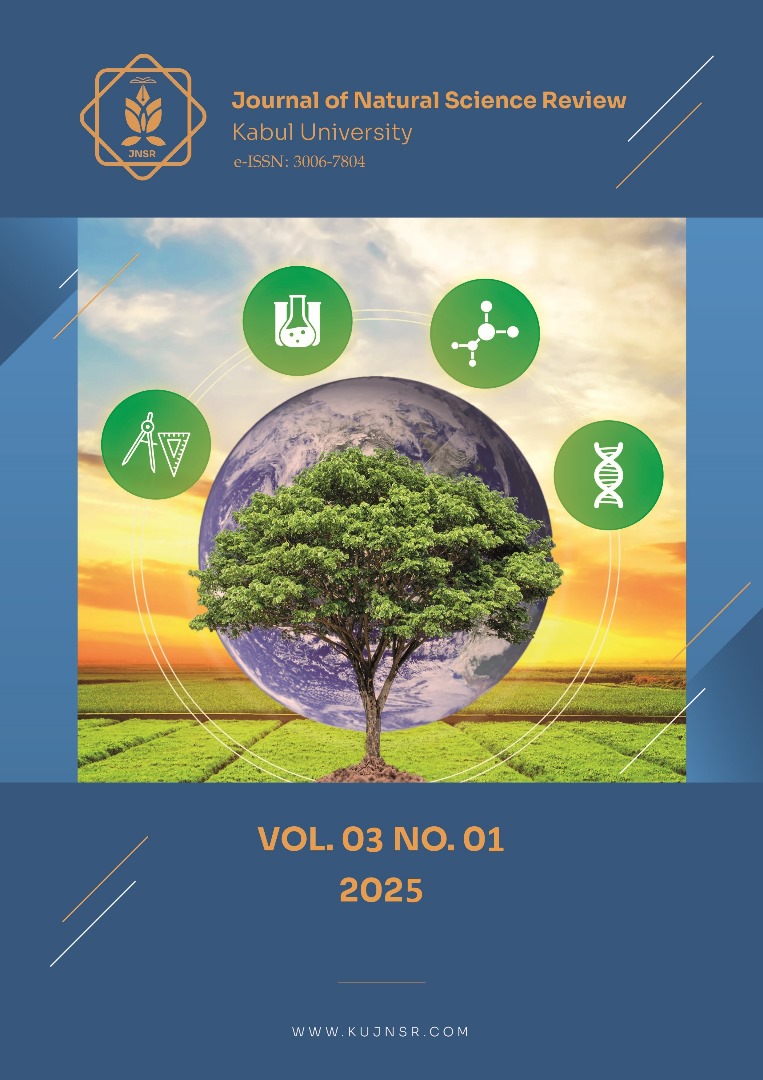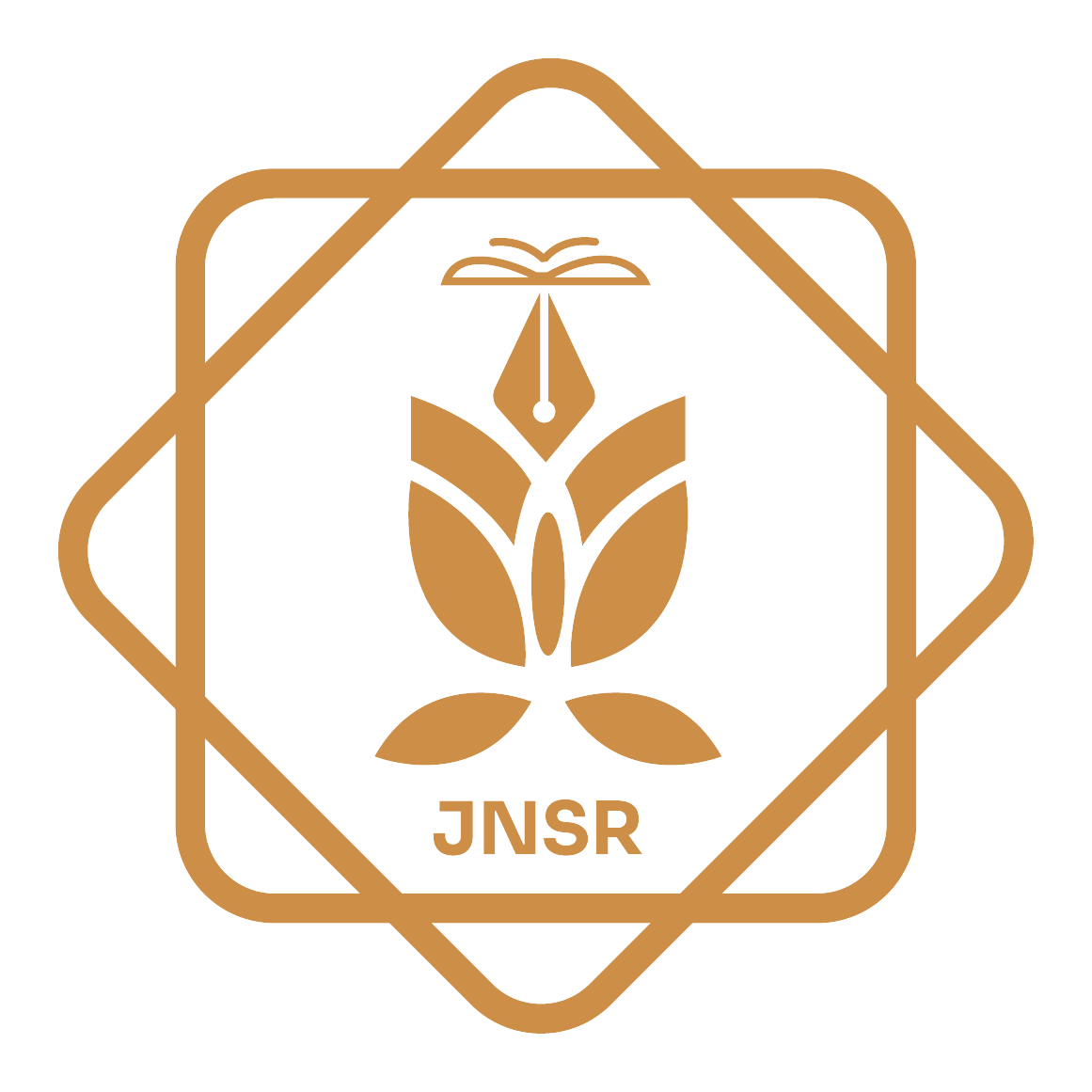Bacterial Contamination and Antibiotic Susceptibility of Isolates from Tanker-Distributed Drinking Water in Kabul, Afghanistan
DOI:
https://doi.org/10.62810/jnsr.v3i1.205Keywords:
Afghanistan, Antibiotic susceptibility, Bacterial quality, Bacterial contaminatio, Tanker waterAbstract
Water quality is critical for public health, and access to safe drinking water is essential for preventing infectious diseases. In many areas of Kabul city, tanker-distributed water is an essential source, but its microbial quality remains uncertain. This cross-sectional study evaluated bacterial contamination and microbial resistance in tanker-distributed treated water in Kabul, comparing it to established standards. One hundred samples from 20 companies were collected between January and June 2024. Samples were cultured for total bacteria and coliform counts using spread plate and filtration methods. Confirmatory tests were performed on colonies. Antibiotic susceptibility was tested by disk diffusion. The results indicated that all samples positive for bacterial contamination exceeded established standards, with 45% containing more than three species. None of the samples contained coliform bacteria. Seventeen distinct bacterial species were identified, including Acinetobacter baumannii (21%) and Staphylococcus aureus (10%). Additionally, the isolates displayed antibiotic resistance, posing significant health risks. Previously, there was a lack of reliable information regarding the bacterial contamination of water distributed by tankers. The results of this study revealed that bacterial contamination in water exceeded accepted standards. Additionally, pathogenic and antibiotic-resistant microorganisms were detected. Therefore, relevant authorities must implement strict control and monitoring measures.
Downloads
References
Access to drinking water—UNICEF DATA. (n.d.). Retrieved March 18 2025, from https://data.unicef.org/topic/water-and-sanitation/drinking-water/
Ashbolt, N. J. (2015). Microbial Contamination of Drinking Water and Human Health from Community Water Systems. Current Environmental Health Reports, 2(1), 95–106. https://doi.org/10.1007/s40572-014-0037-5 DOI: https://doi.org/10.1007/s40572-014-0037-5
Babaei, A., Ghafari Zadeh, F., Normoradi, H., Ahmadi Angali, K., Moslemnia, M., & Salimi, J. (2014). Investigation on the Microbial Quality of Water Treatment centers in Abadan City. Journal of Ilam University of Medical Sciences, 22(4), 132–140.
Baquero, F., Martínez, J.-L., & Cantón, R. (2008). Antibiotics and antibiotic resistance in water environments. Current Opinion in Biotechnology, 19(3), 260–265. https://doi.org/10.1016/j.copbio.2008.05.006 DOI: https://doi.org/10.1016/j.copbio.2008.05.006
Cabral, J. P. S. (2010). Water microbiology. Bacterial pathogens and water. International Journal of Environmental Research and Public Health, 7(10), 3657–3703. https://doi.org/10.3390/ijerph7103657 DOI: https://doi.org/10.3390/ijerph7103657
Chauhan, A., Goyal, P., Varma, A., & Jindal, T. (2017). Microbiological evaluation of drinking water sold by roadside vendors of Delhi, India. Applied Water Science, 7(4), 1635–1644. https://doi.org/10.1007/s13201-015-0315-x DOI: https://doi.org/10.1007/s13201-015-0315-x
Chidya, R. C. G., Singano, L., Chitedze, I., & Mourad, K. A. (2019). Standards Compliance and Health Implications of Bottled Water in Malawi. International Journal of Environmental Research and Public Health, 16(6), 951. https://doi.org/10.3390/ijerph16060951 DOI: https://doi.org/10.3390/ijerph16060951
Constantine, K., Massoud, M., Alameddine, I., & El-Fadel, M. (2017). The role of the water tankers market in water stressed semi-arid urban areas:Implications on water quality and economic burden. Journal of Environmental Management, 188, 85–94. https://doi.org/10.1016/j.jenvman.2016.11.065 DOI: https://doi.org/10.1016/j.jenvman.2016.11.065
Criteria, N. R. C. (U.S.) S. on M. (1985). Selection of Indicator Organisms and Agents as Components of Microbiological Criteria. In An Evaluation of the Role of Microbiological Criteria for Foods and Food Ingredients. National Academies Press (U.S.). https://www.ncbi.nlm.nih.gov/books/NBK216669/
Cockerill, F. R. (2013). Performance standards for antimicrobial susceptibility testing: twenty-third informational supplement. (No Title).
Daud, M. K., Nafees, M., Ali, S., Rizwan, M., Bajwa, R. A., Shakoor, M. B., Arshad, M. U., Chatha, S. A. S., Deeba, F., Murad, W., Malook, I., & Zhu, S. J. (2017). Drinking Water Quality Status and Contamination in Pakistan. BioMed Research International, 2017, 7908183. https://doi.org/10.1155/2017/7908183 DOI: https://doi.org/10.1155/2017/7908183
Ferreira, D. C., Graziele, I., Marques, R. C., & Gonçalves, J. (2021). Investment in drinking water and sanitation infrastructure and its impact on waterborne diseases dissemination: The Brazilian case. Science of The Total Environment, 779, 146279. https://doi.org/10.1016/j.scitotenv.2021.146279 DOI: https://doi.org/10.1016/j.scitotenv.2021.146279
Gil, A. I., Lanata, C. F., Hartinger, S. M., Mäusezahl, D., Padilla, B., Ochoa, T. J., Lozada, M., Pineda, I., & Verastegui, H. (2014). Fecal contamination of food, water, hands, and kitchen utensils at the household level in rural areas of Peru. Journal of Environmental Health, 76(6), 102–106.
Glen, K. A., & Lamont, I. L. (2021). β-lactam Resistance in Pseudomonas aeruginosa: Current Status, Future Prospects. Pathogens (Basel, Switzerland), 10(12), 1638. https://doi.org/10.3390/pathogens10121638 DOI: https://doi.org/10.3390/pathogens10121638
Hamad, A. A., Sharaf, M., Hamza, M. A., Selim, S., Hetta, H. F., & El-Kazzaz, W. (2022). Investigation of the Bacterial Contamination and Antibiotic Susceptibility Profile of Bacteria Isolated from Bottled DrinkingWater. Microbiology Spectrum, 10(1), e0151621. https://doi.org/10.1128/spectrum.01516-21 DOI: https://doi.org/10.1128/spectrum.01516-21
Hamdard, M. H. (2023, November 27). An assessment of drinking water quality in Afghanistan [Väitöskirja]. Jultika.Oulu.Fi. https://oulurepo.oulu.fi/handle/10024/46450.
Hochstrat, R., Wintgens, T., Kazner, C., Melin, T., & Gebel, J. (2010). Options for water scarcity and drought management—The role of desalination. Desalination and Water Treatment, 18(1–3), 96–102. https://doi.org/10.5004/dwt.2010.1347 DOI: https://doi.org/10.5004/dwt.2010.1347
Jéquier, E., & Constant, F. (2010). Water as an essential nutrient: The physiological basis of hydration. European Journal of Clinical Nutrition, 64(2), 115–123. https://doi.org/10.1038/ejcn.2009.111 DOI: https://doi.org/10.1038/ejcn.2009.111
Jia, S., Shi, P., Hu, Q., Li, B., Zhang, T., & Zhang, X.-X. (2015). Bacterial Community Shift Drives Antibiotic Resistance Promotion during Drinking Water Chlorination. Environmental Science & Technology, 49(20), 12271–12279. https://doi.org/10.1021/acs.est.5b03521 DOI: https://doi.org/10.1021/acs.est.5b03521
Kilari, V. B., & Oroszi, T. (2024). The Misuse of Antibiotics and the Rise of Bacterial Resistance: A Global Concern. Pharmacology & Pharmacy, 15(12), Article 12. https://doi.org/10.4236/pp.2024.1512028 DOI: https://doi.org/10.4236/pp.2024.1512028
M26 AE Bactericidal Activity of Antimicrobial Agents. (n.d.). Clinical & Laboratory Standards Institute. Retrieved March 19 2025, from https://clsi.org/standards/products/microbiology/documents/m26/
Ma, F., Xu, S., Tang, Z., Li, Z., & Zhang, L. (2021). Use of antimicrobials in food animals and impact of transmission of antimicrobial resistance on humans. Biosafety and Health, 3(1), 32–38. https://doi.org/10.1016/j.bsheal.2020.09.004 DOI: https://doi.org/10.1016/j.bsheal.2020.09.004
Manaia, C. M., Rocha, J., Scaccia, N., Marano, R., Radu, E., Biancullo, F., Cerqueira, F., Fortunato, G., Iakovides, I. C., Zammit, I., Kampouris, I., Vaz-Moreira, I., & Nunes, O. C. (2018). Antibiotic resistance in wastewater treatment plants: Tackling the black box. Environment International, 115, 312–324. https://doi.org/10.1016/j.envint.2018.03.044 DOI: https://doi.org/10.1016/j.envint.2018.03.044
Mock, C. N., Nugent, R., Kobusingye, O., & Smith, K. R. (Eds.). (2017). Disease Control Priorities, Third Edition (Volume 7): Injury Prevention and Environmental Health. The World Bank. https://doi.org/10.1596/978-1-4648-0522-6 DOI: https://doi.org/10.1596/978-1-4648-0522-6
Moghadam, Y. J., Nowroozi, H., & Abdollahi, N. (2020). How to Supply Drinking Water by Implementing Dual Plans in Small Communities (Case Study: Kowsar Complex, Ferdows). علوم و مهندسی آب و فاضلاب, 5(1), 46–54. https://doi.org/10.22112/JWWSE.2020.160666.1127
Mohammadi Kouchesfahani, M., Alimohammadi, M., Nabizadeh Nodehi, R., Aslani, H., Rezaie, S., & Asadian, S. (2015). Pseudomonas aeruginosa and Heterotrophic Bacteria Count in Bottled Waters in Iran. Iranian Journal of Public Health, 44(11), 1514–1519.
Mumtaz, M. W., Adnan, A., Mukhtar, H., Nawaz, K., Raza, A., & Ahmad, Z. (2011). Estimation of bacteriological levels in surface water samples to evaluate their contamination profile. Environmental Monitoring and Assessment, 172(1), 581–587. https://doi.org/10.1007/s10661-010-1357-z DOI: https://doi.org/10.1007/s10661-010-1357-z
Sepehr, M. N., Jafari, N., & Tavani, S. M. (2021). Assessing the quality of water output from desalination plants and water tankers in QOM and comparison with national standards and WHO.. https://doi.org/10.52547/jehe.8.4.465 DOI: https://doi.org/10.52547/jehe.8.4.465
Pant, N. D., Poudyal, N., & Bhattacharya, S. K. (2016). Bacteriological quality of bottled drinking water versus municipal tap water in Dharan municipality, Nepal. Journal of Health, Population, and Nutrition, 35(1), 17. https://doi.org/10.1186/s41043-016-0054-0 DOI: https://doi.org/10.1186/s41043-016-0054-0
Popkin, B. M., D'Anci, K. E., & Rosenberg, I. H. (2010). Water, hydration, and health. Nutrition Reviews, 68(8), 439–458. https://doi.org/10.1111/j.1753-4887.2010.00304.x DOI: https://doi.org/10.1111/j.1753-4887.2010.00304.x
Sanganyado, E., & Gwenzi, W. (2019). Antibiotic resistance in drinking water systems: Occurrence, removal, and human health risks. The Science of the Total Environment, 669, 785–797. https://doi.org/10.1016/j.scitotenv.2019.03.162 DOI: https://doi.org/10.1016/j.scitotenv.2019.03.162
Schafer, C. A., & Mihelcic, J. R. (2012). Effect of storage tank material and maintenance on household water quality. Journal AWWA, 104(9). https://doi.org/10.5942/jawwa.2012.104.0125 DOI: https://doi.org/10.5942/jawwa.2012.104.0125
Shariatpanahi, M., & Anderson, A. C. (1987). Bacterial survey of well water—Tehran, Iran. Environmental Research, 43(2), 285–289. https://doi.org/10.1016/S0013-9351(87)80029-4 DOI: https://doi.org/10.1016/S0013-9351(87)80029-4
Tang, K. W. K., Millar, B. C., & Moore, J. E. (2023). Antimicrobial Resistance (AMR). British Journal of Biomedical Science, 80, 11387. https://doi.org/10.3389/bjbs.2023.11387 DOI: https://doi.org/10.3389/bjbs.2023.11387
Tulchinsky, T. H., & Varavikova, E. A. (2014). Environmental and Occupational Health. The New Public Health, 471–533. https://doi.org/10.1016/B978-0-12-415766-8.00009-4 DOI: https://doi.org/10.1016/B978-0-12-415766-8.00009-4
Uddin, T. M., Chakraborty, A. J., Khusro, A., Zidan, B. R. M., Mitra, S., Emran, T. B., Dhama, K., Ripon, M. K. H., Gajdács, M., Sahibzada, M. U. K., Hossain, M. J., & Koirala, N. (2021). Antibiotic resistance in microbes: History, mechanisms, therapeutic strategies and future prospects. Journal of Infection and Public Health, 14(12), 1750–1766. https://doi.org/10.1016/j.jiph.2021.10.020 DOI: https://doi.org/10.1016/j.jiph.2021.10.020
UNICEF, & World Health Organization. (2022). Progress on drinking water, sanitation, and hygiene: 2000-2022. Joint Monitoring Programme (JMP) for Water Supply, Sanitation, and Hygiene. https://doi.org/10.1016/j.washdev.2022.04.001
UNICEF. (2022). Afghanistan: WASH on the Brink. UNICEF. https://www.unicef.org/media/118356/file/%20UNICEF%20Afghanistan%20WASH%20on%20the%20Brink%202022.pdf.
U.S. Environmental Protection Agency. (2007). Effectiveness of disinfectant residuals in drinking water. U.S. Environmental Protection Agency. Retrieved from https://www.epa.gov/sites/default/files/2021-05/documents/effectiveness_of_disinfectant_residuals_final_-_3-7-07.pdf
Walsh, T. R. (2005). The emergence and implications of metallo-beta-lactamases in Gram-negative bacteria. Clinical Microbiology and Infection: The Official Publication of the European Society of Clinical Microbiology and Infectious Diseases, 11 Suppl 6, 2–9. https://doi.org/10.1111/j.1469-0691.2005.01264.x
Walsh, T. R. (2005). The emergence and implications of metallo‐β‐lactamases in Gram‐negative bacteria. Clinical microbiology and infection, 11, 2-9. https://doi.org/10.1111/j.1469-0691.2005.01264.x DOI: https://doi.org/10.1111/j.1469-0691.2005.01264.x
World Bank. (2021, December 17). Building resilience to address Afghanistan's food security crisis. World Bank. https://blogs.worldbank.org/en/endpovertyinsouthasia/building-resilience-to-address-afghanistan-s-food-security-crisis
World Health Organization. (2017). Guidelines for drinking-water quality: Fourth edition incorporating the first addendum. Retrieved from https://www.who.int/publications/i/item/9789241549950
World Health Organization. (2024). Drinking-water. World Health Organization. https://www.who.int/news-room/fact-sheets/detail/drinking-water
Yousufi, H., Hamid, H. 0799253506, Habibi Khishki, K., Haidari, N., & Mohammadi, S. (2024). Evaluation of contamination and antibiotic susceptibility pattern of bacteria isolated from bottled water in Kabul, Afghanistan. Water and Environmental Sustainability, 4(1), 39–44. https://doi.org/10.52293/WES.4.1.3944 DOI: https://doi.org/10.52293/WES.4.1.3944
Zahid, S., Asmawi, M. Z., & Abdullah, M. F. (2021). Residents' Perception on the Impact of Urban Development on Water Quality in Kabul City, Afghanistan. International Journal of Academic Research in Business and DOI: https://doi.org/10.6007/IJARBSS/v11-i6/10212
Downloads
Published
How to Cite
Issue
Section
License
Copyright (c) 2025 Mohammad Aman Bahaduri, Hamidullah Rasekh, Abdul Ahmad Tahmasibi

This work is licensed under a Creative Commons Attribution-NonCommercial 4.0 International License.



























